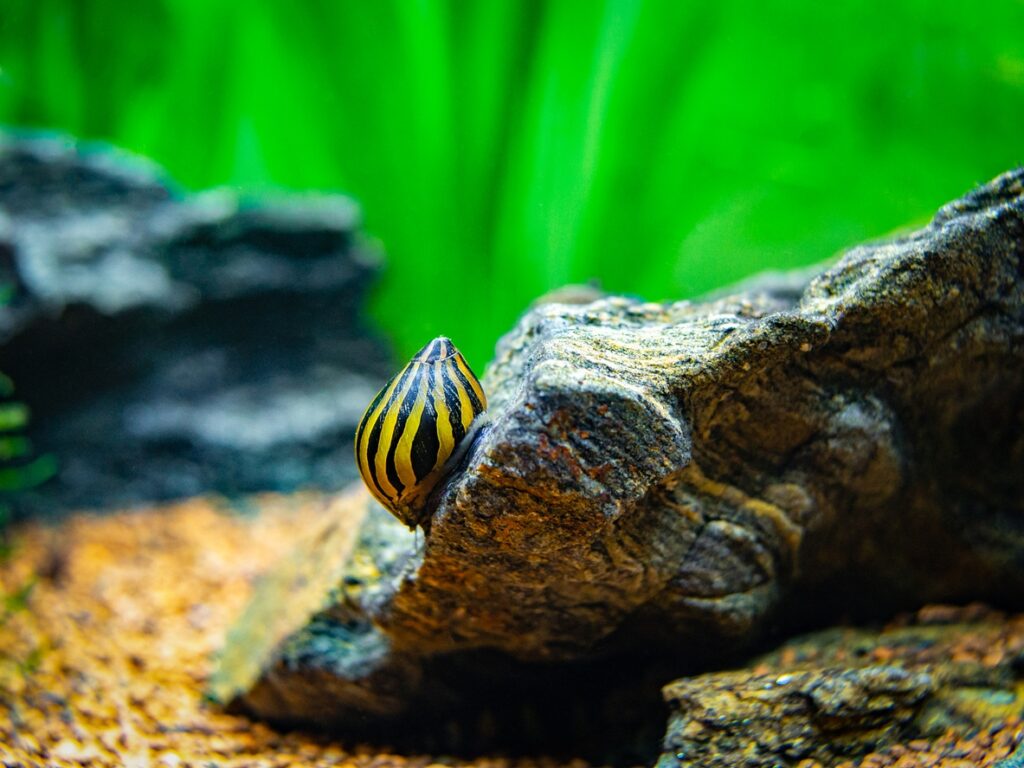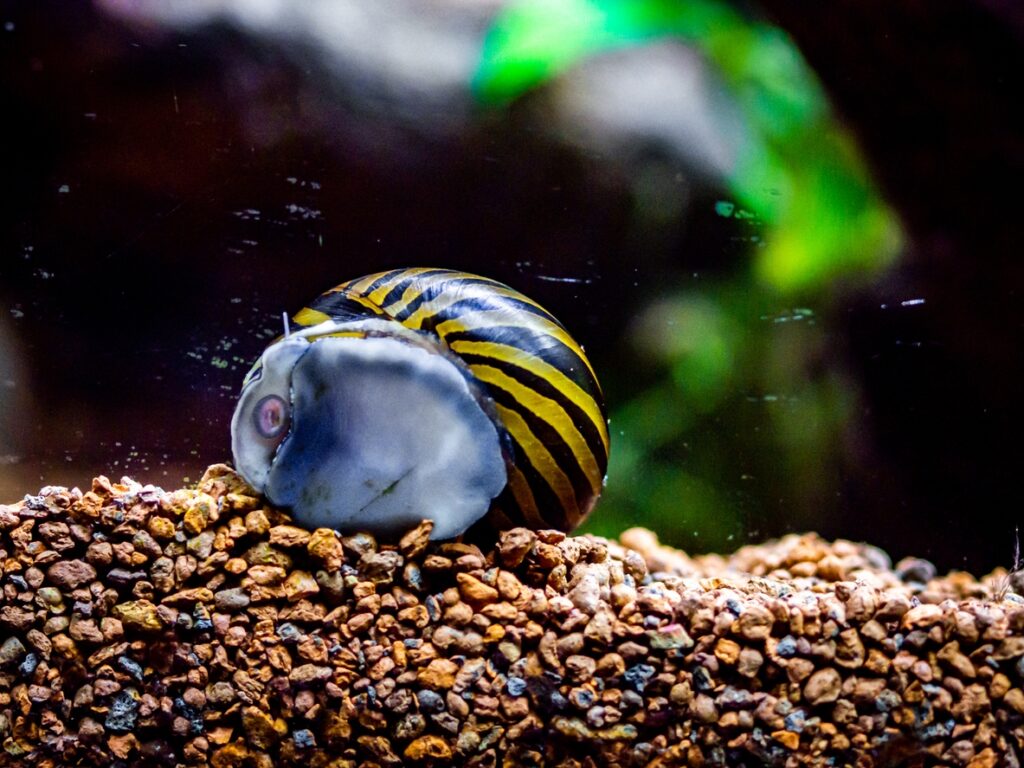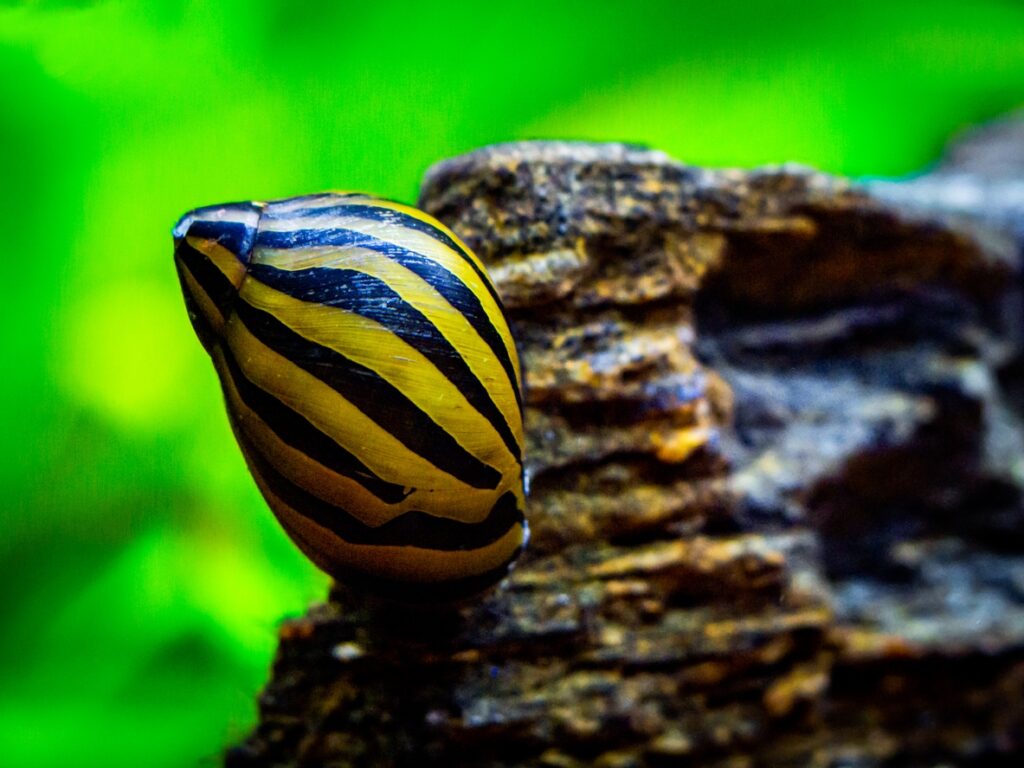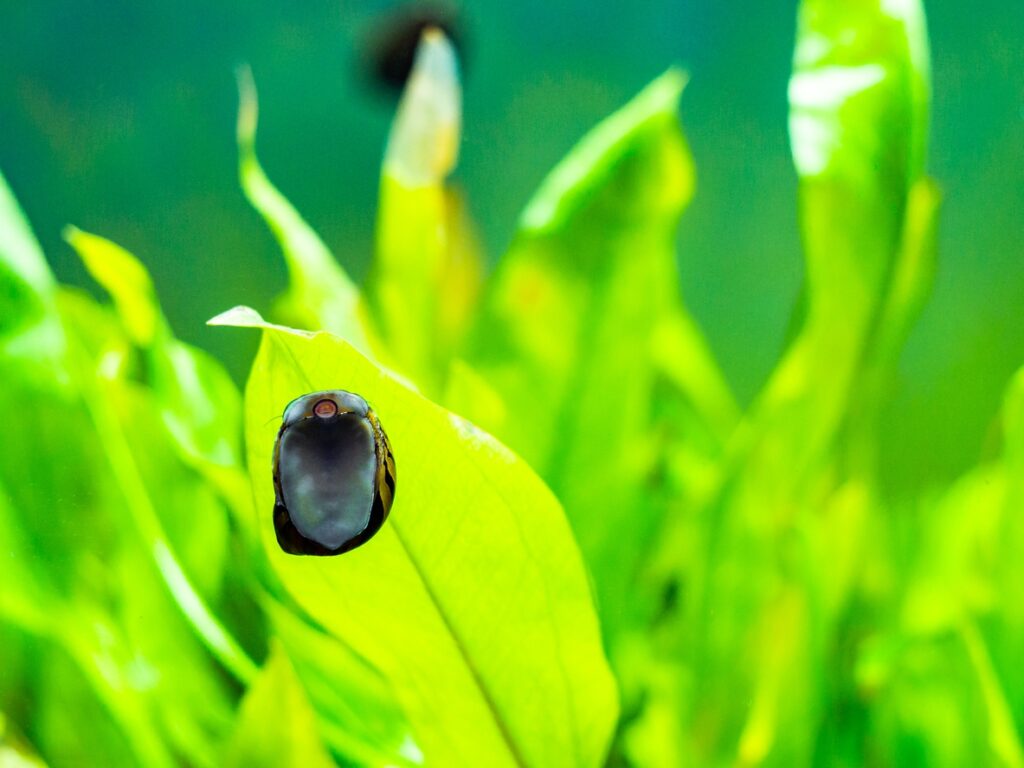What Are Nerite Snails?
Nerite snails are some of the most common snails in the world. The majority are saltwater snails that spend their entire lives in the ocean.
However a few have managed to penetrate brackish and even freshwater environments. They do so in order to chase the food source they love most: algae.

Nerites come in an assortment of colors, ranging from dull to strikingly bold. The majority are small, round snails from ½ to 1 inch in length found in shallow water. Here algae grows best and there is plenty of sunlight.
While they sound ordinary there is actually a lot to discuss when keeping these hearty vegetarians.
This nerite snail care guide is designed to ensure you succeed with your first nerites!
Types of Nerite Snails
There are actually hundreds of types of nerite snails all over the world, found in freshwater, brackish, and marine environments. However, these are the five that are by far the most commonly encountered in the aquarium trade.
- Zebra Nerite Snail
Also known as Neritina natalensis, the Zebra Nerite Snail is the most popular and desirable out of the commonly available types of nerite snails!
Zebra Snails get their name from their alternating pattern of wavy black and brown bands, reminiscent of the land-dwelling mammal. Zebra Nerites are native to South and East Africa in freshwater, brackish, and marine environments. And the majority reach roughly an inch in length when fully grown.
Horned Nerite Snail
Clithon corona and C. diadema are the Horned Nerite Snails. These species are much smaller than their cousins, maxing out anywhere from ½ to 1 inch in length.
Horned Nerite Snails are from East and Southeast Asia (China, Vietnam, Thailand, Indonesia) and they are just as effective at eating algae. They get their name from the spiky, defensive protrusions along their shells – which also make them pricier than other nerites!
Olive Nerite Snail
The Olive Nerite Snail, or Neritina reclivata, is probably the least visually appealing of the common types of nerite snails. But it’s not unattractive, either, with thin, wavy black stripes on an olive green background and a jet black body.
Coupled with their round shell and delicate central swirl, they look exactly like an olive slowly cruising around your aquarium looking for algae!
Tiger Nerite Snail
The Tiger Nerite Snail is another popular and easy-to-find type of nerite snail. Their scientific name is Neritina semiconica and they are also found in South and East Africa.
Tiger Nerites grow to be around an inch in length and are identical in care to their close relative, the Zebra Nerite Snail.
Black Racer Nerite Snail
Black Racer Nerite Snails are also known as the Military Nerite Snail due to their resemblance to a helmet patrolling the aquarium! And by the scientific community as Neritina pulligera. Black Racers are larger than the others, growing up to 1½ inches in length.
They are also noticeably faster than their cousins, “racing” around the tank when not grazing on a tasty patch of algae.
Caring for Nerite Snails
While they look radically different from one another, caring for all types of freshwater nerite snails is more or less the same.
They are beautiful, undemanding, and hard-working aquarium residents that everyone should try keeping!

Water Conditions for Nerites
Nerite snails are undemanding when it comes to water conditions so long as you avoid certain extremes. Like all snails, they have a hard, exterior shell made of calcium carbonate. This shell can be eroded in certain conditions, including soft, acidic water (pH <7.0). Therefore it’s better to keep them in hard, alkaline water chemistries (pH >7.0)
The five species I mentioned above live mostly or exclusively in freshwater.
However, they all will also thrive in brackish water environments and many other species are saltwater snails that live entirely in the ocean. Nerite snail eggs of all kinds do need saltwater to develop properly but the adults do fine in freshwater. The freshwater species tend to migrate toward the sea. Or they live in tidal regions where marine and brackish water pushes into their environment on a daily basis.
Adding a bit of aquarium salt is therefore very beneficial to nerite snails even if it’s not fully brackish water.
It’s also a general tonic for most aquarium fish since salt helps regulate ion exchange across gill membranes and stimulates slime coat production. Just don’t go overboard, otherwise, you might suddenly end up with loads of baby snails to care for.
Nerite Snails and Nitrogenous Waste Products
Nerite snails are slightly sensitive to elevated levels of nitrogenous waste products. That includes not only ammonia but also nitrite and nitrate. Invertebrates in general are more sensitive to these compounds than fish.
So always add them last to an aquarium. This gives the tank time to fully biologically cycle so that all nitrogenous waste products are properly broken down.
You want to be especially careful with snails when it comes to water quality because it’s hard to tell if a snail has died.
After all, snails are fine with not moving for long periods of time. Worse, they have a tendency to rot very quickly, as anyone who has ended up with spoiled shellfish can confirm. The decay of a dead nerite snail can cause an instant ammonia spike in your aquarium. Which is harmful to your other pets and potentially deadly for other nerites.
Nerite Snails and Aquascaping
When aquascaping for Zebra Snails and their relatives we want to ensure that there are hard surfaces available. These places grow plenty of algae and biofilm for them to feast on.
Normally that’s not a problem since the aquarium glass and decorations will provide enough surface area for one or a few snails. But you can always add algae wafers if they eat it all.

But what if you have a heavily planted tank, driftwood, and other decorations with loads of surface area? A single olive nerite snail may not be able to keep up with all of the algae that can build up. You may need several nerites to keep algae under control.
Another nice thing about nerite snails is that they are entirely plant-safe. They won’t eat plants, something other freshwater snails sometimes do if they can’t find enough food to eat.
If you see what appears to be snail damage it’s more likely that your nerites were eating dead and decaying plant tissue. This is invaluable because feeding on decaying matter prevents it from simply rotting, which can result in higher levels of ammonia formation.
If you have driftwood and have touched it anytime during cleaning then you’ve likely noticed that it’s become slimy from being submerged for so long.
But don’t decide that it’s dirty and start scrubbing away that slime!
That layer of biofilm is made of bacteria, protists, and other microorganisms. And it’s one of the best food sources for nerite snails and other grazing animals. Even many fish, including Bristlenose Plecos, love munching on driftwood biofilm.
Feeding Nerite Snails
Nerite snails of all varieties are almost entirely vegetarian, feeding on decaying plants, biofilms that grow on aquarium hard surfaces, and algae. However, if you have too many nerites you may run out of algae and biofilm for them to graze on. Remember, these little guys eat pretty much all day long.
So you may end up needing to feed your nerite snails to keep them healthy. Fortunately feeding them is very easy to do as they are unfussy eaters.
They are not just algae eaters but also detritivores, meaning they eat leftover organic matter like flakes and pellets your fish miss during feeding.
Most prepared fish food blends aren’t the best for nerite snails since they contain loads of animal protein, which nerites don’t need. Spirulina flakes are a great food source for nerite snails, as well as omnivorous and vegetarian fish like Silver Dollars, Platies, and Mollies.
You can also feed them algae wafers, prepared tablets that use a mixture of vegetables, grain, and algae pressed into dried form! People often feed these to plecos and other bottom-feeding algae eaters.
Tiger nerite snails will even eat blanched terrestrial vegetables like cabbage, spinach, and zucchini!
All you need to do is use a veggie clip attached to the glass with a leaf of their favorite greens and they will quickly move in to begin feeding!
Nerite Snails and Algae
Algae issues are the number one reason why people buy and keep nerite snails. Many aquatic snails eat algae, including Bladder Snails, Ramshorn Snails and Mystery Snails. But few snails are as dedicated as nerites and none are as easily kept under control!
Nerite snails will eat most types of green algae, including hair, green spot, and green slime algae, the types most commonly found in aquariums. Nerites will eat brown algae, something many algae eaters won’t touch, though they only eat it if there is no green algae to be found.
They will even eat the problematic staghorn and black beard algae; two red algae varieties that are toxic enough to deter most other algae-eating animals.
But again, they usually save these more noxious types of algae for last, preferring to feast on green algae of all kinds.
Tank Mates for Nerite Snails
Nerite snails are extremely peaceful animals. All they want is to feed on algae and be left alone to do so. Zebra snails are entirely peaceful towards each other as well, ignoring other snails unless they are ready to mate or have a spot of algae on their shells that needs a touch-up.
So keep them with other animals that are equally peaceful and inoffensive. Nerite snails also don’t have an operculum, a defensive “door” attached to their foot that other snails use to close off their shells.
This means that nerites that fall on their back are easy targets for determined fish looking to pick at their soft foot.
Sometimes the trailing antennae of nerite snails are tempting targets for fish that are normally peaceful. Fin nipping fish like barbs may be tempted to snap at their antennae. So watch them carefully and remove your nerites if any signs of aggression occur.
Choose bottom-dwelling tank mates especially carefully. Peaceful bottom dwellers include Corydoras, Dwarf Otocinclus, and freshwater shrimp. Stay away from crabs and crayfish, both of which are predatory and will eventually eat your nerite snails like escargot.
Pufferfish are an especially poor choice, even the tiny Pea Puffer. Pufferfish are all specialist invertebrate hunters with sharp teeth and will tear your poor nerite snails to pieces. Or simply swallow them whole.
Good Tank Mates for Nerite Snails:
- Guppies, Tetras, Mollies, Cherry Barbs, Danios, Gouramis, and other small, peaceful Community Fish
- Corydoras, Dwarf Otocinclus, and other peaceful Bottom Dwellers
- Snails, Freshwater Shrimp, Freshwater Clams, and other peaceful Invertebrates
Poor Tank Mates for Nerite Snails:
- Pufferfish, Cichlids, large Barbs, and other predatory or aggressive fish
- Crabs and Crayfish
Breeding Nerite Snails

Believe it or not, nerite snails are both easy and difficult to breed. If your nerite snails are happy with their environment and finding plenty of algae to eat then it is inevitable that they will mate and lay eggs.
But the difficulty lies in the fact that nerite snail eggs require brackish or even full saltwater in order to develop properly and hatch. Nerite snail larvae are shell-less marine organisms that eventually migrate back to brackish and freshwater environments.
On the bright side, this means that nerite snails tend not to get out of control the way Ramshorn Snails do. But it makes successfully breeding them impossible in most aquariums unless you have a brackish tank with Scats, Mollies, and other salt-loving animals.
Even if you were to get nerite snail eggs in a brackish or marine tank, the larvae are free-floating when newly hatched. This means that they are more than likely going to be sucked up into your filter or protein skimmer and killed. It takes a lot of dedication and luck to successfully breed nerite snails in a home aquarium.
All those eggs can be a bit of a hassle, though, since they are bright white and tend to be scattered on hard surfaces like the tank glass where they can be easily seen. They aren’t gelatinous like the eggs of other snails. Nerite snail eggs are more like hard little pearls that need to be scraped away. That said, they will eventually decay if there is no salt present and other animals can then pick them away from the surface where they’ve been laid.
In Conclusion
Nerite snails are a favorite of aquarists all over the world. Unlike other snails, there is no risk of them taking over a freshwater aquarium. And they are excellent algae eaters that will eat the green stuff for days. Plus they happen to be very beautiful and come in all kinds of colors and patterns. Overall, there are few downsides and many upsides to keeping them.
FAQ About Nerite Snails
Nerites are some of the best algae-eating snails in the hobby. And they don’t get out of control like other freshwater snails because their eggs require salt to develop.
Zebra nerite snails will eat all forms of green, red, and brown algae. They will also eat decaying plant matter, vegetables like spinach, and leftover fish food.
Nerite snails have no social needs whatsoever. They will ignore each other unless they are ready to breed and otherwise don’t get lonely.
Nerite snails are easy to keep and useful in keeping your aquarium clean, making them great pets for all fish keepers!

